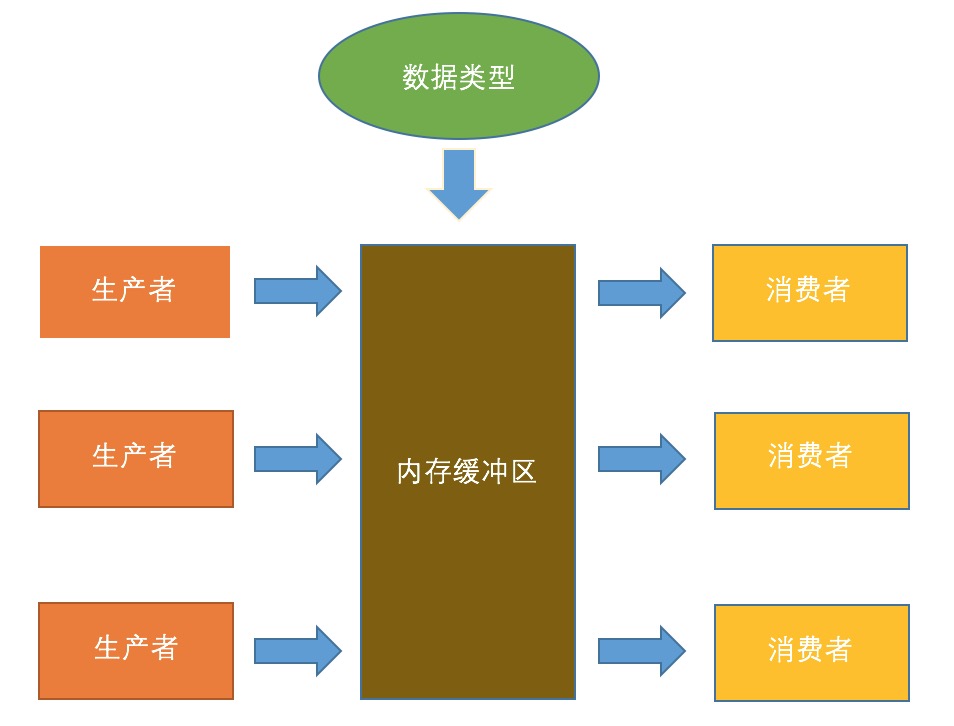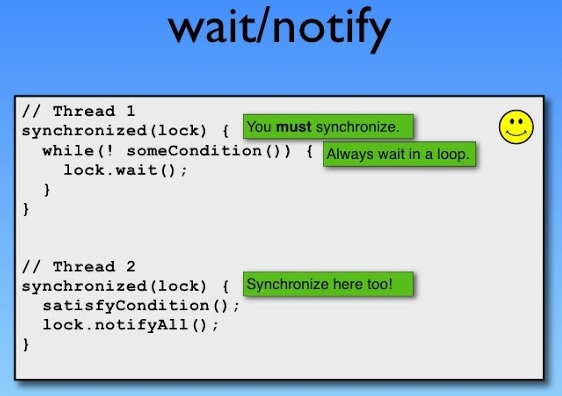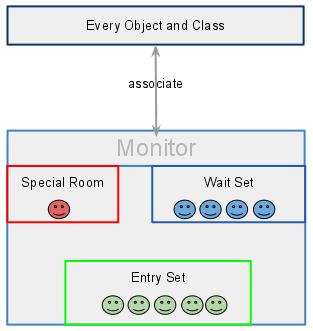- content
总结java线程基础知识
- wait、notify、notifyAll
一. 示例
1. 方法介绍
void notify() Wakes up a single thread that is waiting on this object’s monitor. 译:唤醒在此对象监视器上等待的单个线程
void notifyAll() Wakes up all threads that are waiting on this object’s monitor. 译:唤醒在此对象监视器上等待的所有线程
void wait( ) Causes the current thread to wait until another thread invokes the notify() method or the notifyAll( ) method for this object. 译:导致当前的线程等待,直到其他线程调用此对象的notify( ) 方法或 notifyAll( ) 方法
void wait(long timeout) Causes the current thread to wait until either another thread invokes the notify( ) method or the notifyAll( ) method for this object, or a specified amount of time has > elapsed. 译:导致当前的线程等待,直到其他线程调用此对象的notify() 方法或 notifyAll() 方法,或者指定的时间过完。
void wait(long timeout, int nanos) Causes the current thread to wait until another thread invokes the notify( ) method or the notifyAll( ) method for this object, or some other thread interrupts the current > thread, or a certain amount of real time has elapsed. 译:导致当前的线程等待,直到其他线程调用此对象的notify( ) 方法或 notifyAll( ) 方法,或者其他线程打断了当前线程,或者指定的时间过完。
2. 简单示例
public class WaitAndNotify {
public static void main(String[] args) {
Object co = new Object();
System.out.println(co);
for (int i = 0; i < 5; i++) {
MyThread t = new MyThread("Thread" + i, co);
t.start();
}
try {
TimeUnit.SECONDS.sleep(2);
System.out.println("-----Main Thread notify-----");
synchronized (co) {
co.notify();
}
TimeUnit.SECONDS.sleep(2);
System.out.println("Main Thread is end.");
} catch (InterruptedException e) {
e.printStackTrace();
}
}
static class MyThread extends Thread {
private String name;
private Object co;
public MyThread(String name, Object o) {
this.name = name;
this.co = o;
}
@Override
public void run() {
System.out.println(name + " is waiting.");
try {
synchronized (co) {
co.wait();
}
System.out.println(name + " has been notified.");
} catch (InterruptedException e) {
e.printStackTrace();
}
}
}
}
运行结果:
java.lang.Object@1540e19d
Thread1 is waiting.
Thread2 is waiting.
Thread0 is waiting.
Thread3 is waiting.
Thread4 is waiting.
-----Main Thread notify-----
Thread1 has been notified.
Main Thread is end.
将其中的那个notify换成notifyAll,运行结果:
Thread0 is waiting.
Thread1 is waiting.
Thread2 is waiting.
Thread3 is waiting.
Thread4 is waiting.
-----Main Thread notifyAll-----
Thread4 has been notified.
Thread2 has been notified.
Thread1 has been notified.
Thread3 has been notified.
Thread0 has been notified.
Main Thread is end.
运行环境jdk8,结论:
notify唤醒一个等待的线程;notifyAll唤醒所有等待的线程。
3. 生产者-消费者问题
什么是生产者-消费者问题?

假设有一个公共的容量有限的池子,有两种人,一种是生产者,另一种是消费者。需要满足如下条件: 1、生产者产生资源往池子里添加,前提是池子没有满,如果池子满了,则生产者暂停生产,直到自己的生成能放下池子。 2、消费者消耗池子里的资源,前提是池子的资源不为空,否则消费者暂停消耗,进入等待直到池子里有资源数满足自己的需求。
public interface AbstractStorage {
void consume(int num);
void produce(int num);
}
import java.util.LinkedList;
/**
* 生产者和消费者的问题
* wait、notify/notifyAll() 实现
*/
public class Storage1 implements AbstractStorage {
//仓库最大容量
private final int MAX_SIZE = 100;
//仓库存储的载体
private LinkedList list = new LinkedList();
//生产产品
public void produce(int num){
//同步
synchronized (list){
//仓库剩余的容量不足以存放即将要生产的数量,暂停生产
while(list.size()+num > MAX_SIZE){
System.out.println("【要生产的产品数量】:" + num + "\t【库存量】:"
+ list.size() + "\t暂时不能执行生产任务!");
try {
//条件不满足,生产阻塞
list.wait();
} catch (InterruptedException e) {
e.printStackTrace();
}
}
for(int i=0;i<num;i++){
list.add(new Object());
}
System.out.println("【已经生产产品数】:" + num + "\t【现仓储量为】:" + list.size());
list.notifyAll();
}
}
//消费产品
public void consume(int num){
synchronized (list){
//不满足消费条件
while(num > list.size()){
System.out.println("【要消费的产品数量】:" + num + "\t【库存量】:"
+ list.size() + "\t暂时不能执行消费任务!");
try {
list.wait();
} catch (InterruptedException e) {
e.printStackTrace();
}
}
//消费条件满足,开始消费
for(int i=0;i<num;i++){
list.remove();
}
System.out.println("【已经消费产品数】:" + num + "\t【现仓储量为】:" + list.size());
list.notifyAll();
}
}
}
public class Producer extends Thread{
//每次生产的数量
private int num ;
//所属的仓库
public AbstractStorage abstractStorage;
public Producer(AbstractStorage abstractStorage){
this.abstractStorage = abstractStorage;
}
public void setNum(int num){
this.num = num;
}
// 线程run函数
@Override
public void run()
{
produce(num);
}
// 调用仓库Storage的生产函数
public void produce(int num)
{
abstractStorage.produce(num);
}
}
public class Consumer extends Thread{
// 每次消费的产品数量
private int num;
// 所在放置的仓库
private AbstractStorage abstractStorage1;
// 构造函数,设置仓库
public Consumer(AbstractStorage abstractStorage1)
{
this.abstractStorage1 = abstractStorage1;
}
// 线程run函数
public void run()
{
consume(num);
}
// 调用仓库Storage的生产函数
public void consume(int num)
{
abstractStorage1.consume(num);
}
public void setNum(int num){
this.num = num;
}
}
public class Test{
public static void main(String[] args) {
// 仓库对象
AbstractStorage abstractStorage = new Storage1();
// 生产者对象
Producer p1 = new Producer(abstractStorage);
Producer p2 = new Producer(abstractStorage);
Producer p3 = new Producer(abstractStorage);
Producer p4 = new Producer(abstractStorage);
Producer p5 = new Producer(abstractStorage);
Producer p6 = new Producer(abstractStorage);
Producer p7 = new Producer(abstractStorage);
// 消费者对象
Consumer c1 = new Consumer(abstractStorage);
Consumer c2 = new Consumer(abstractStorage);
Consumer c3 = new Consumer(abstractStorage);
// 设置生产者产品生产数量
p1.setNum(10);
p2.setNum(10);
p3.setNum(10);
p4.setNum(10);
p5.setNum(10);
p6.setNum(10);
p7.setNum(80);
// 设置消费者产品消费数量
c1.setNum(50);
c2.setNum(20);
c3.setNum(30);
// 线程开始执行
c1.start();
c2.start();
c3.start();
p1.start();
p2.start();
p3.start();
p4.start();
p5.start();
p6.start();
p7.start();
}
}
更简洁的生产者-消费者代码
import java.util.LinkedList;
import java.util.Queue;
import java.util.Random;
/**
* Simple Java program to demonstrate How to use wait, notify and notifyAll()
* method in Java by solving producer consumer problem.
*
* @author Javin Paul
*/
public class ProducerConsumerInJava {
public static void main(String args[]) {
System.out.println("How to use wait and notify method in Java");
System.out.println("Solving Producer Consumper Problem");
Queue<Integer> buffer = new LinkedList<>();
int maxSize = 10;
Thread producer = new Producer(buffer, maxSize, "PRODUCER");
Thread consumer = new Consumer(buffer, maxSize, "CONSUMER");
producer.start();
consumer.start();
}
}
/**
* Producer Thread will keep producing values for Consumer
* to consumer. It will use wait() method when Queue is full
* and use notify() method to send notification to Consumer
* Thread.
*
* @author WINDOWS 8
*
*/
class Producer extends Thread
{
private Queue<Integer> queue;
private int maxSize;
public Producer(Queue<Integer> queue, int maxSize, String name){
super(name);
this.queue = queue;
this.maxSize = maxSize;
}
@Override
public void run()
{
while (true){
synchronized (queue) {
while (queue.size() == maxSize) {
try {
System.out .println("Queue is full, " + "Producer thread waiting for " + "consumer to take something from queue");
queue.wait();
} catch (Exception ex) {
ex.printStackTrace();
}
}
Random random = new Random();
int i = random.nextInt();
System.out.println("Producing value : " + i);
queue.add(i);
queue.notifyAll();
}
}
}
}
/**
* Consumer Thread will consumer values form shared queue.
* It will also use wait() method to wait if queue is
* empty. It will also use notify method to send
* notification to producer thread after consuming values
* from queue.
*
* @author WINDOWS 8
*
*/
class Consumer extends Thread {
private Queue<Integer> queue;
private int maxSize;
public Consumer(Queue<Integer> queue, int maxSize, String name){
super(name);
this.queue = queue;
this.maxSize = maxSize;
}
@Override public void run() {
while (true) {
synchronized (queue) {
while (queue.isEmpty()) {
System.out.println("Queue is empty," + "Consumer thread is waiting" + " for producer thread to put something in queue");
try {
queue.wait();
} catch (Exception ex) {
ex.printStackTrace();
}
}
System.out.println("Consuming value : " + queue.remove()); queue.notifyAll();
}
}
}
}
问题
1. 为什么wait、notify必须在持有锁的情况下才能执行?
a. 如果在未持有对象锁的情况下调用object.wait()/notify(),直接会报错,JDK已经做好保护。
b. 判断条件与wait()方法分为两个步骤,在不加锁的情况下,假设thread1在执行到两个步骤中间的时候thread2执行了条件设置和nofity()方法,那thread1的wait就错过了notify通知。
通过互斥锁来保证wait()/notify()之间的先后顺序,才能保证wait不会错过notify,从而导致wait线程一直挂着。

2. 为什么在Object中提供wait、nodify方法?为什么不是在Thread中提供?
a. wait()方法告诉当前线程释放监视器(monitor)并将线程放入等待队列,直到其它线程进入相同的监视器(monitor)并调用nodify()
b. notify()唤醒在这个对象的监视器(monitor)上等待的单个线程
c. 这两个方法是线程之间通信的方式,都是monitor级别的方法,monitor是关联到Object的而不是Thread的(所有对象都有监视器monitor)
d. 如果仅仅在Thread中提供这两种方法,那一个线程必须知道其它线程的状态,其它线程在等待哪些资源,这样才能(调用thread2.nofity())通知它们去获取这些资源,然而在java里面线程之间是无法互相知道对方状态的

参考
Java多线程学习之wait、notify/notifyAll 详解
为什么wait,notify和notifyAll要与synchronized一起使用?
Why must wait() always be in synchronized block
How can the wait() and notify() methods be called on Objects that are not threads?